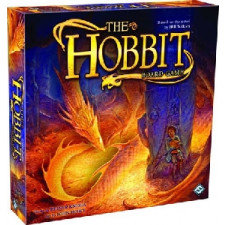The Hobbit Review
on Aug 5, 2015
Back at the turn of the 21st century, Knizia designed what was arguably the first modern cooperative game in Lord of the Rings. It has become a highwater mark not only for the cooperative genre but also for its brilliant marriage of theme and mechanisms, as no game since has quite captured the heart and soul of the Fellowship’s journey the way that fantastic little system did some 15 years ago. A decade later, he took his famed design prowess and applied it to Tolkien’s other perennial classic, The Hobbit. While this design is certainly aimed more pointedly at children and families, it retains the heart of what made Lord of the Rings great: mechanisms that don’t bash you in the face with the setting, but rather subtly suggest the theme throughout the play.
Take, for instance, the core mechanism that advances the rowdy band of dwarves and their Hobbit burglar across Middle-Earth. Players are asked to secretly choose a numbered card, and the order of these will determine which player takes (or loses) which valuable resources. The system encourages players to glance sideways at their so-called friends at the table, trying to surmise who is going to try to horde all the provisions, who is going to make a grab for the One Ring, and who is going to blow a card in order to save up for the next challenge. It’s stupidly simple, and yet it delivers the theme perfectly: the dwarves aren’t fighting each other directly, but if they can pocket some extra resources here or there, they’ll do it the first chance they get.
The game’s pacing is also congruous with the book. The uneasy alliance will stumble and tumble down the board, stopping at several key confrontations in order to score victory points. The game tracks each character’s growth and progress along several tracks, so players will feel the slow but steady improvement of their dwarves before they at last face Smaug in a final showdown. Like the book before it, it’s a pleasant, enjoyable, quiet journey punctuated with action set pieces--taking the form of an easy, simple, Knizian dice game.
I highly recommend playing with the semi-cooperative variant, where Smaug not only acts as a game timer but also as a loss condition for the whole group. Should every player pass on a dice challenge, Smaug will advance another space toward Laketown. If he arrives to make the town his tasty second breakfast, all players lose the game. This creates an interesting blend of strategizing as a group as to who should take on each challenge and selfish moves to snag some treasure for yourself. According to Tolkien, Thorin and his band of dwarves are “decent enough people... if you don't expect too muchâ€, and that’s exactly the feel that’s conveyed by the simple design elements of The Hobbit.
While Knizia skillfully conveys the necessarily conflicted nature of a quest undertaken by a bunch of moderately selfish dwarves, the dice-based adventures themselves are fairly abstract. You’re simply rolling 5 dice and hoping for some symbols, and then applying some bonuses or re-rolls depending on how strong your dwarf has gotten. It doesn’t really have a counterpart in the game world, so you’ve just got to accept that the card says you’re evading some wood elves or fighting a goblin and move on. The dice are pretty unforgiving too, so characters that haven’t managed to grab a stat boost by the second or third challenge will start to find themselves slipping behind the rest of the pack. And since the stats come fairly evenly to all players, it’s just a good upgrade card or two that will see the leaders start to peel away from the losers.
Yet despite the apparent directness of the game’s available strategies and tactics, there are a few elements that take a play or two to emerge. Players will need to figure out the relative value of the provision resource (lovingly dubbed “bread†by my group), and they’ll start to see the challenge inherent in deciding whether to blow a super-high card now or to save it for when it’s really needed. When the game session gets rolling, everyone will get what’s going on with no trouble and eagerly start pulling event cards. But within a few turns, people have their heads in their hands, checking other dwarves’ boards, peering at the upcoming symbols on the journey track, or glancing at how much precious bread is required for the next challenge. It’s not overly deep, but there’s a delightfu amount of strategy tucked away in the two-page rulebook.
Knizia has never been one to be tossed to and fro by the fickle winds of game design trends, and The Hobbit is no exception. It’s probably a little too long for most younger children, who won’t quite grasp the conflicting demands the game presents to the player. It’s also just a little too long to become standard filler fare, so it occupies a precarious place in the market. But if you are one of the brilliant, beautiful people who appreciated Knizia’s Lord of the Rings masterpiece, and you have slightly older children or a game group that’s not afraid of a simpler affair, you’ll have a fun few outings with The Hobbit.

 Customer Support
Customer Support  Subscribe
Subscribe 




 Account
Account  Wishlist
Wishlist 

